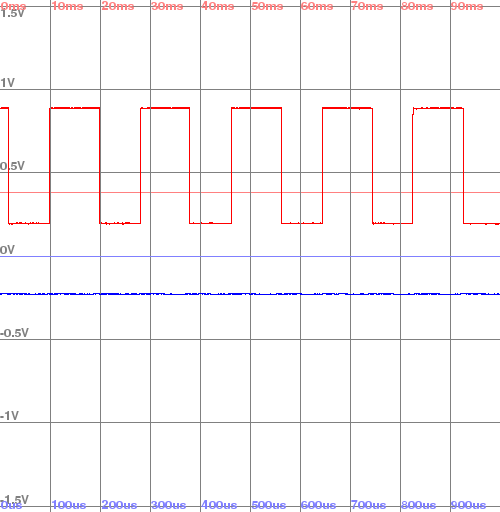ADCQ1706 USB Oscilloscope
On a trip to Japan I bought one of these strange USB oscilloscopes. It seems it was designed for use with a Raspberry Pi, but I wanted to use it on a regular Linux desktop PC. Fortunately, the available "client" software for the RPi is written in Python, but it has several limitations. It's all in Japanese and it looks to be based around a web-server capturing still images. However, due to source code availability, I could easily create a new client.
What I present here is a Python PyGame-based solution instead, which has a graphical screen that updates in real time:

I have uploaded the code to GitLab and GitHub, but it's also presented here:
#!/usr/bin/python
import serial
import pygame
import time
class Oscilloscope(object):
def __init__(self, tty_dev='/dev/ttyUSB0', trig_level=2048):
self._con = serial.Serial(tty_dev, 115200, timeout=2.0)
self._settings = {
1 : {'hsync' : 3, 'trig' : trig_level, 'rise' : 1},
2 : {'hsync' : 3, 'trig' : trig_level, 'rise' : 1}}
def get_samples(self, channel):
hsync = str(self._settings[channel]['hsync'])
trig = str(self._settings[channel]['trig'])
rise = str(self._settings[channel]['rise'])
self._con.write('ST' + hsync + str(channel) + trig + rise + 'E')
data = self._con.read(4003)
if len(data) != 4003:
return None
if not (data[0] == 'S') and (data[1] == 'M') and (data[4002] == 'E'):
return None
samples = list()
for i in range(0, 2000):
samples.append(int((ord(data[i*2+2]) & 0x7F) + (ord(data[i*2+3]) & 0x1F) * 128))
return samples
def increase_hsync(self, channel):
if self._settings[channel]['hsync'] < 6:
self._settings[channel]['hsync'] += 1
def decrease_hsync(self, channel):
if self._settings[channel]['hsync'] > 0:
self._settings[channel]['hsync'] -= 1
def get_hsync(self, channel):
return self._settings[channel]['hsync']
def toggle_trig_rise(self, channel):
if self._settings[channel]['rise'] == 1:
self._settings[channel]['rise'] = 0
else:
self._settings[channel]['rise'] = 1
def increase_trig_level(self, channel):
if self._settings[channel]['trig'] < 3968:
self._settings[channel]['trig'] += 256
def decrease_trig_level(self, channel):
if self._settings[channel]['trig'] > 128:
self._settings[channel]['trig'] -= 256
def get_trig_level(self, channel):
return self._settings[channel]['trig']
class GUI(object):
def __init__(self, oscilloscope, scale=1):
if scale not in [1,2,4]:
raise Exception("Invalid scale")
self._scale = scale
self._osc = oscilloscope
self._ch_active = {1 : True, 2 : True}
pygame.init()
pygame.display.set_caption("Oscilloscope")
self._screen = pygame.display.set_mode((500 * scale, 512 * scale))
self._font = pygame.font.Font(pygame.font.get_default_font(), 12 * scale)
def _toggle_channel(self, channel):
if self._ch_active[channel] == True:
self._ch_active[channel] = False
else:
self._ch_active[channel] = True
def _draw_samples(self, samples, color):
prev_y = None
for sample_no, sample in enumerate(samples):
y = (4096 - sample) / (8 / self._scale)
x = sample_no / (4 / self._scale)
if prev_y == None:
prev_y = y
pygame.draw.line(self._screen, color, (x, prev_y), (x, y))
prev_y = y
def _draw_volt_grid(self):
for pos, volt in [(48,1.5), (715,1), (1381,0.5), (2048,0), (2715,-0.5), (3381,-1), (4048,-1.5)]:
y = pos / (8 / self._scale)
pygame.draw.line(self._screen, (128, 128, 128), (0, y), ((500 * self._scale), y))
text = self._font.render(str(volt) + "V", True, (128, 128, 128))
if text.get_height() > y:
self._screen.blit(text, (0, y + (1 * self._scale)))
else:
self._screen.blit(text, (0, y - text.get_height() + (1 * self._scale)))
def _draw_time_grid(self, channel, color):
hsync = self._osc.get_hsync(channel)
if hsync == 0:
time = [0,5,10,15,20,25,30,35,40,45]
unit = "us"
elif hsync == 1:
time = [0,10,20,30,40,50,60,70,80,90]
unit = "us"
elif hsync == 2:
time = [0,50,100,150,200,250,300,350,400,450]
unit = "us"
elif hsync == 3:
time = [0,100,200,300,400,500,600,700,800,900]
unit = "us"
elif hsync == 4:
time = [0,1,2,3,4,5,6,7,8,9]
unit = "ms"
elif hsync == 5:
time = [0,2,4,6,8,10,12,14,16,18]
unit = "ms"
elif hsync == 6:
time = [0,10,20,30,40,50,60,70,80,90]
unit = "ms"
for index in range(0, 10):
x = index * (50 * self._scale)
if x > 0:
pygame.draw.line(self._screen, (128, 128, 128), (x, 0), (x, (512 * self._scale)))
text = self._font.render(str(time[index]) + unit, True, color)
if channel == 1:
self._screen.blit(text, (x + (1 * self._scale), 0))
if channel == 2:
self._screen.blit(text, (x + (1 * self._scale), (512 * self._scale) - text.get_height()))
def _draw_trig_line(self, channel, color):
y = (4096 - self._osc.get_trig_level(channel)) / (8 / self._scale)
pygame.draw.line(self._screen, color, (0, y), ((500 * self._scale), y))
def loop(self):
while True:
for event in pygame.event.get():
if event.type == pygame.QUIT:
return
elif event.type == pygame.KEYDOWN:
if event.key == pygame.K_ESCAPE or event.key == pygame.K_q:
return
elif event.key == pygame.K_s:
pygame.image.save(self._screen, "oscilloscope.png")
print "Screenshot saved to 'oscilloscope.png'."
elif event.key == pygame.K_1:
self._toggle_channel(1)
elif event.key == pygame.K_2:
self._toggle_channel(2)
elif event.key == pygame.K_3:
self._osc.increase_hsync(1)
elif event.key == pygame.K_4:
self._osc.decrease_hsync(1)
elif event.key == pygame.K_5:
self._osc.increase_hsync(2)
elif event.key == pygame.K_6:
self._osc.decrease_hsync(2)
elif event.key == pygame.K_7:
self._osc.toggle_trig_rise(1)
elif event.key == pygame.K_8:
self._osc.toggle_trig_rise(2)
elif event.key == pygame.K_e:
self._osc.increase_trig_level(1)
elif event.key == pygame.K_r:
self._osc.decrease_trig_level(1)
elif event.key == pygame.K_t:
self._osc.increase_trig_level(2)
elif event.key == pygame.K_y:
self._osc.decrease_trig_level(2)
self._screen.fill((255,255,255))
self._draw_volt_grid()
if self._ch_active[1]:
self._draw_time_grid(1, (255,128,128))
self._draw_trig_line(1, (255,128,128))
samples = self._osc.get_samples(1)
self._draw_samples(samples, (255,0,0))
if self._ch_active[2]:
self._draw_time_grid(2, (128,128,255))
self._draw_trig_line(2, (128,128,255))
samples = self._osc.get_samples(2)
self._draw_samples(samples, (0,0,255))
if (not self._ch_active[1]) and (not self._ch_active[2]):
time.sleep(0.1) # To avoid 100% CPU usage.
pygame.display.flip()
if __name__ == "__main__":
import sys
import getopt
def print_usage_and_exit():
print "Usage: %s [options]" % (sys.argv[0])
print "Options:"
print " -h Display this help and exit."
print " -d DEV Serial TTY DEV to use instead of /dev/ttyUSB0."
print " -s SCALE Scale of GUI, value 1, 2 or 4."
print " "
sys.exit(1)
def print_keys():
print "Keys:"
print " 1 = Toggle channel #1"
print " 2 = Toggle channel #2"
print " 3 = Increase time/div for channel #1"
print " 4 = Decrease time/div for channel #1"
print " 5 = Increase time/div for channel #2"
print " 6 = Decrease time/div for channel #2"
print " 7 = Toggle rise/fall trigging for channel #1"
print " 8 = Toggle rise/fall trigging for channel #2"
print " E = Increase trig level for channel #1"
print " R = Decrease trig level for channel #1"
print " T = Increase trig level for channel #2"
print " Y = Decrease trig level for channel #2"
print " S = Screenshot"
print " Q = Quit"
try:
opts, args = getopt.getopt(sys.argv[1:], "hd:s:")
except getopt.GetoptError as err:
print "Error:", str(err)
print_usage_and_exit()
tty_dev = None
scale = None
for o, a in opts:
if o == '-h':
print_usage_and_exit()
elif o == '-d':
tty_dev = a
elif o == '-s':
scale = int(a)
if tty_dev:
osc = Oscilloscope(tty_dev)
else:
osc = Oscilloscope()
if scale:
gui = GUI(osc, scale)
else:
gui = GUI(osc)
print_keys()
gui.loop()




